Advocating for PCB Victims: Non-Governmental Organizations (NGOs)
- Last Updated: June 12th, 2025

Attorney Jessie Paluch, founder of TruLaw, has over 25 years of experience as a personal injury and mass tort attorney, and previously worked as an international tax attorney at Deloitte. Jessie collaborates with attorneys nationwide — enabling her to share reliable, up-to-date legal information with our readers.
Legally Reviewed
This article has been written and reviewed for legal accuracy and clarity by the team of writers and legal experts at TruLawsuit Info and is as accurate as possible. This content should not be taken as legal advice from an attorney. If you would like to learn more about our owner and experienced injury lawyer, Jessie Paluch, you can do so here.
Fact-Checked
TruLawsuit Info does everything possible to make sure the information in this article is up to date and accurate. If you need specific legal advice about your case, contact our team by using the chat on the bottom of this page. This article should not be taken as advice from an attorney.
Key Takeaways:
- Research has shown that PCB exposure can lead to numerous health problems, including skin conditions, such as chloracne, and may have serious impacts on the immune, reproductive, nervous, and endocrine systems.
- Once widely used in electrical equipment, hydraulic systems, and as additives in paints, PCBs were eventually banned in the late 1970s due to their health risks and persistence in the environment.
- Government agencies like the U.S. Environmental Protection International Agency offer assistance and information on PCB regulations
Overview of Advocating for PCB Victims
On this page, we’ll discuss an overview of advocacy for PCB victims, the role of non-governmental organizations (NGOs) in supporting victims of PCB exposure, resources available for those affected by PCBs, and much more.
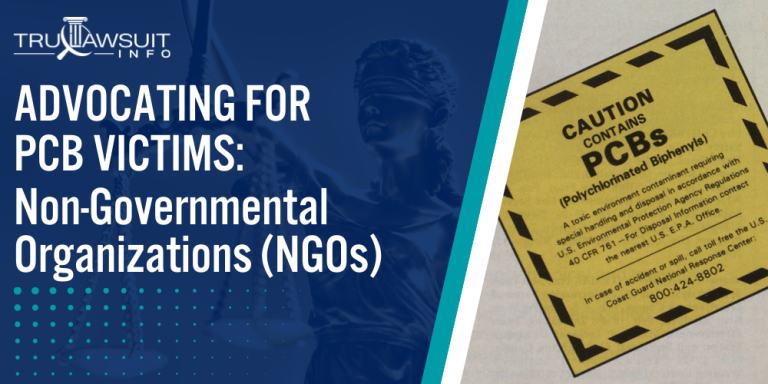
Intro to Advocacy for PCB Victims
NGOs advocate for the rights and well-being of PCB victims by offering support, resources, and a platform to raise awareness about the long-lasting effects of PCB exposure.
Here are some key ways NGOs assist PCB victims:
- Medical Assistance: Providing resources and information about specialized medical care for PCB-related health issues.
- Community Outreach: Organizing events and campaigns to educate the public about the dangers of PCBs and the importance of supporting victims.
- Policy Advocacy: Lobbying for stricter regulations on PCB use and cleanup for better support around the affected communities.
If you or a loved one has experienced adverse health conditions after being exposed to PCB chemicals, you may qualify to pursue compensation.
Contact TruLawsuit Info using the chat on this page to receive an instant case evaluation to determine if you qualify to file a PCB lawsuit today.
Table of Contents
Engaging Communities in PCB Cleanup Planning
Effective PCB cleanup requires not only technical solutions but also active community engagement.
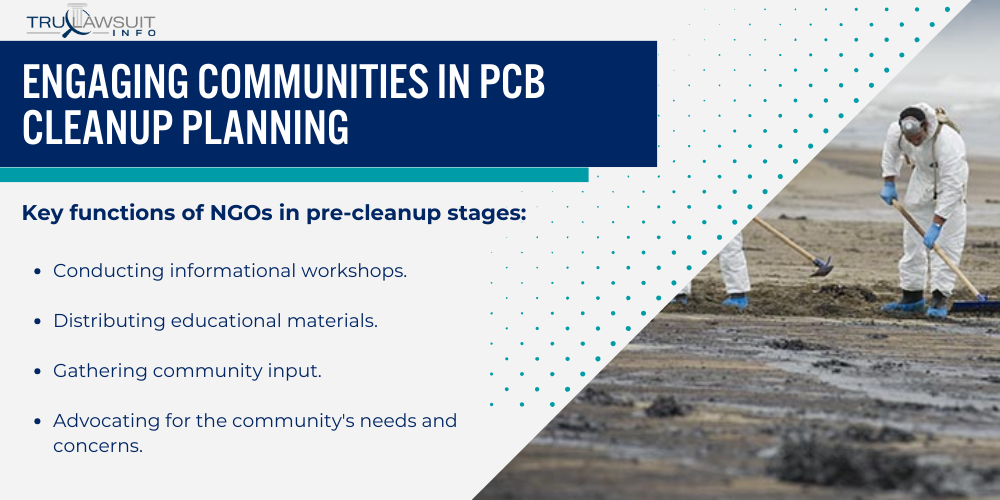
Ensuring that local communities and PCB-exposed populations are involved in the cleanup planning process is essential for addressing the health implications of PCB contamination and promoting transparent processes.
Involvement of NGOs in Pre-Cleanup Community Engagement
Non-Governmental Organizations (NGOs) play a vital role in connecting clean-up agencies with affected communities.
They facilitate dialogue and education on the health risks associated with PCB exposure.
Key functions of NGOs in pre-cleanup stages:
- Conducting informational workshops.
- Distributing educational materials.
- Gathering community input.
- Advocating for the community’s needs and concerns.
These initial engagements cultivate a foundation of trust and transparency essential for the success of any PCB cleanup initiative.
Formulating Community-Centric PCB Cleanup Plans with NGOs
Community-centric planning, guided by NGOs, prioritizes the voices and well-being of those most affected.
Essential components of these plans include:
- Identifying key health implications for local populations.
- Designing cleanup strategies with community input.
- Ensuring accessible communication channels.
- Establishing ongoing community feedback mechanisms.
All strategies are tailored to reduce PCB-related health risks sustainably and effectively, with NGOs serving as a crucial liaison between communities and cleanup authorities.
Certifying Cleanup Efforts with Transparency and NGO Support
Transparency is key to ensuring that clean-up efforts are both effective and acknowledged by the community.
NGOs support transparent certification by:
- Monitoring cleanup progress.
- Providing third-party validation of cleanup claims.
- Reporting on health implications post-cleanup.
- Engaging the community in reviewing cleanup outcomes.
This transparent certification process helps maintain public confidence and holds responsible parties accountable for restoring a safe environment.
Leveraging Financial Strategies for Effective PCB Remediation
Effective polychlorinated biphenyl (PCB) remediation requires significant financial resources.
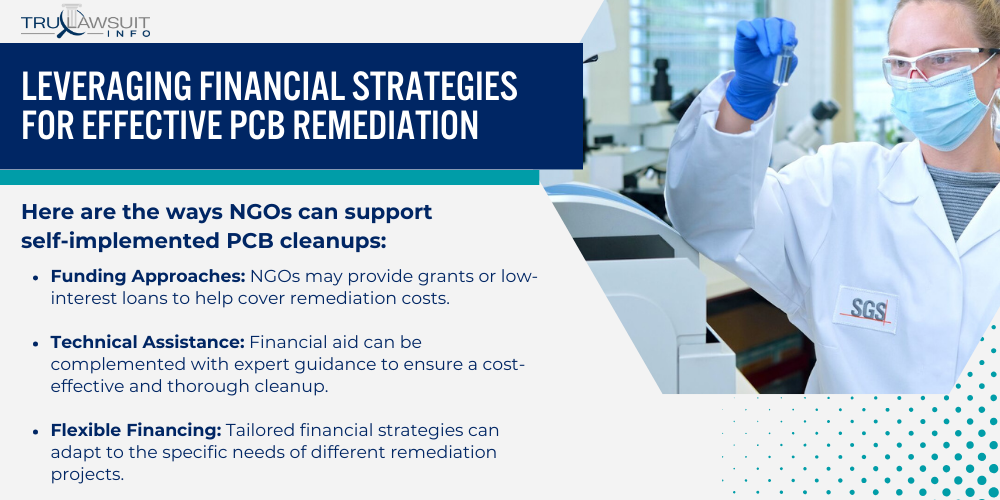
It’s crucial for stakeholders to understand the role that non-governmental organizations (NGOs) can play in facilitating these efforts through strategic funding and advocacy.
Facilitating Self-Implemented PCB Cleanups via NGO Funding
NGOs can offer critical financial support to parties affected by PCB contamination.
This approach allows entities to manage the cleanup process proactively.
Here are the ways NGOs can support self-implemented PCB cleanups:
- Funding Approaches: NGOs may provide grants or low-interest loans to help cover remediation costs.
- Technical Assistance: Financial aid can be complemented with expert guidance to ensure a cost-effective and thorough cleanup.
- Flexible Financing: Tailored financial strategies can adapt to the specific needs of different remediation projects.
- Replicable Models: Successful self-implemented cleanup projects can serve as models for future NGO funding programs.
NGOs Advocating for Performance-Based PCB Cleanup Funding
Performance-based funding has emerged as a novel strategy to enhance PCB remediation efforts.
Benefits of Performance-Based Funding:
- Milestone Payments: Funding is released as certain remediation milestones are reached, ensuring progress.
- Result-Oriented: NGOs can argue for funding mechanisms that incentivize reaching specific cleanup outcomes.
- Accountability: Such strategies promote transparency and accountability in the use of funds.
- Efficiency: Advocacy for performance-based initiatives can reduce cleanup times and costs.
Ensuring Insurance Equity for PCB Cleanup with NGO Advocacy
NGO advocacy can play a pivotal role in negotiating fair insurance policies to support PCB cleanups.
Here’s how NGOs can help achieve insurance equity:
- Insurance Claims Guidance: NGOs can help claimants navigate the often challenging process of filing insurance claims for PCB cleanup.
- Policy Analysis: By analyzing insurance policies, NGOs can identify coverage gaps and advocate for broader protections.
- Legal Support: Organizations may provide legal counsel to assure fair treatment in insurance disputes.
- Equitable Frameworks: Through lobbying, NGOs work towards creating more equitable insurance frameworks that reflect the true costs and needs of PCB remediation.
By promoting sound financial strategies, insurance equity, and performance-based incentives, NGOs contribute significantly to the effective remediation of PCB-afflicted sites.
They ensure that financial and regulatory challenges are met with proactive and innovative solutions.
Enhancing PCB Waste Disposal Through NGO Partnerships
Efforts to manage polychlorinated biphenyl (PCB) waste have increasingly involved nongovernmental organizations (NGOs).
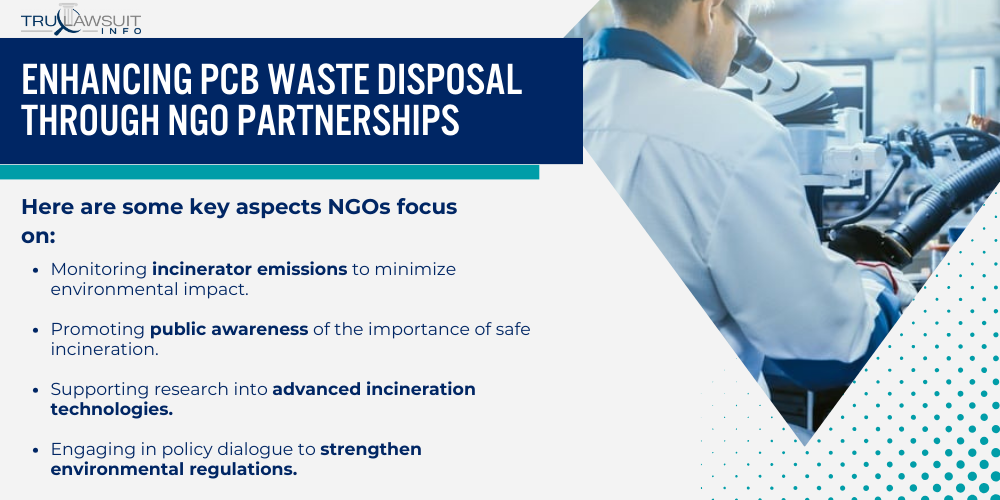
These collaborations have improved practices around PCB disposal, ensuring they are more environmentally conscious and community-oriented.
Advocacy for Environmentally Safe PCB Incineration Methods
NGOs play a pivotal role in advocating for environmentally safe incineration methods.
They work to ensure that the incineration process complies with stringent regulatory frameworks.
Here are some key aspects NGOs focus on:
- Monitoring incinerator emissions to minimize environmental impact.
- Promoting public awareness of the importance of safe incineration.
- Supporting research into advanced incineration technologies.
- Engaging in policy dialogue to strengthen environmental regulations.
Environmental safety in the incineration of PCBs is addressed by the EPA regulations and supported by an NGO in the policy-making process.
Promoting Alternative PCB Disposal with NGO Support
NGOs actively promote alternative disposal methods for PCBs.
They play a crucial role in the following areas:
- Educating communities about safe disposal techniques.
- Collaborating with governments to pilot new disposal methods.
- Lobbying for funding and support of environmentally friendly alternatives.
- Assisting in the implementation of green disposal solutions.
NGOs support initiatives that utilize methods other than incineration, recognizing that there are multiple pathways for safe PCB congeners.
Securing Landfill Approvals Through NGO Community Mobilization
NGOs frequently assist communities in the landfill approval process.
Their involvement includes:
- Gathering community input to inform landfill siting decisions.
- Facilitating discussions between communities and regulatory agencies.
- Providing expertise on environmentally safe landfill operation.
- Advocating for responsible landfill management practices.
Through these efforts, NGOs help ensure that landfills for PCB disposal meet community and environmental standards.
Facilitating Coordinated Approval Processes with NGOs
NGOs are essential in coordinating approval processes for PCB disposal.
They synergize efforts between parties by:
- Establishing a clear line of communication between stakeholders.
- Streamlining approval timelines through effective collaboration.
- Offering technical guidance to simplify regulatory compliance.
- Acting as intermediaries to reconcile various interests and priorities.
A coordinated effort with NGOs ensures that disposal procedures adhere to regulations while also addressing community concerns, as demonstrated in resources like the PCB Facility Approval Streamlining Toolbox (PCB FAST).
Streamlining Risk-Based PCB Cleanup with NGO Collaboration
Organizations are increasingly seeking to enhance the efficiency of risk-based PCB cleanup by leveraging partnerships with non-governmental organizations (NGOs).
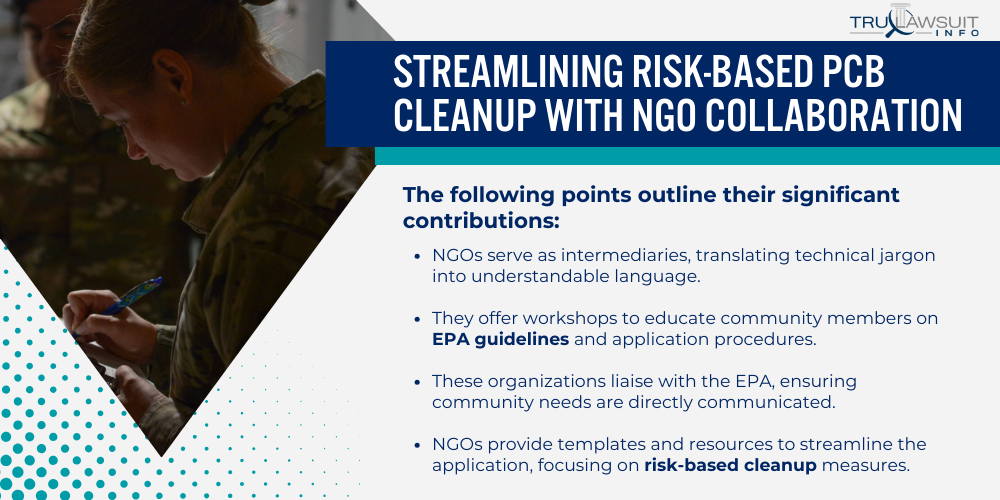
These collaborations are vital in simplifying application processes for affected communities and refining cleanup approaches that align with EPA standards while adding the persuasive power of environmental advocacy.
Simplifying Application Processes for Communities via NGOs
NGOs play a substantial role in assisting communities with simplified application processes.
The following points outline their significant contributions:
- NGOs serve as intermediaries, translating technical jargon into understandable language.
- They offer workshops to educate community members on EPA guidelines and application procedures.
- These organizations liaise with the EPA, ensuring community needs are directly communicated.
- NGOs provide templates and resources to streamline the application, focusing on risk-based cleanup measures.
PCB Cleanup Approaches Through NGO Initiatives
NGOs play a vital role in empowering communities by providing them with the knowledge and resources necessary to tackle PCB contamination.
Through collaborative efforts, NGOs and communities can explore a wider range of cleanup options.
By integrating NGO initiatives, communities can access diverse strategies for PCB remediation:
- NGOs introduce proven, cost-effective cleanup methods that communities might not otherwise consider.
- They promote sustainable practices that lead to the long-term well-being of the affected areas.
- Collaborative efforts can pilot innovative technologies for risk-based cleanup.
- Successes and learnings from NGO-led projects are often shared to improve broader EPA decisions.
Influencing EPA’s PCB Cleanup with Environmental Advocacy
Environmental advocacy groups are the bridge between the public and the EPA on PCB issues.
They raise awareness of PCB-related problems, influencing public opinion and, by extension, regulatory influence.
Environmental advocacy groups play a critical role in shaping how policies and guidelines are developed:
- These groups raise awareness of PCB-related issues, influencing public opinion and, by extension, regulatory influence.
- NGOs can leverage their networks to support communities in voicing concerns and suggestions to the EPA.
- By presenting well-researched alternatives, they sometimes sway EPA strategies for the better.
- High-profile advocacy can lead to swifter action and more stringent regulations on PCB cleanup.
The concerted efforts of NGOs with communities show a pathway to a more efficient and effective risk-based PCB cleanup, amplifying the community’s voice in EPA decisions and bringing about meaningful environmental advancements.
NGO-Led Emergency Responses to PCB Contamination
Non-governmental organizations (NGOs) play a pivotal role in addressing the dangerous aftermath of PCB contamination during emergency responses and disaster management.
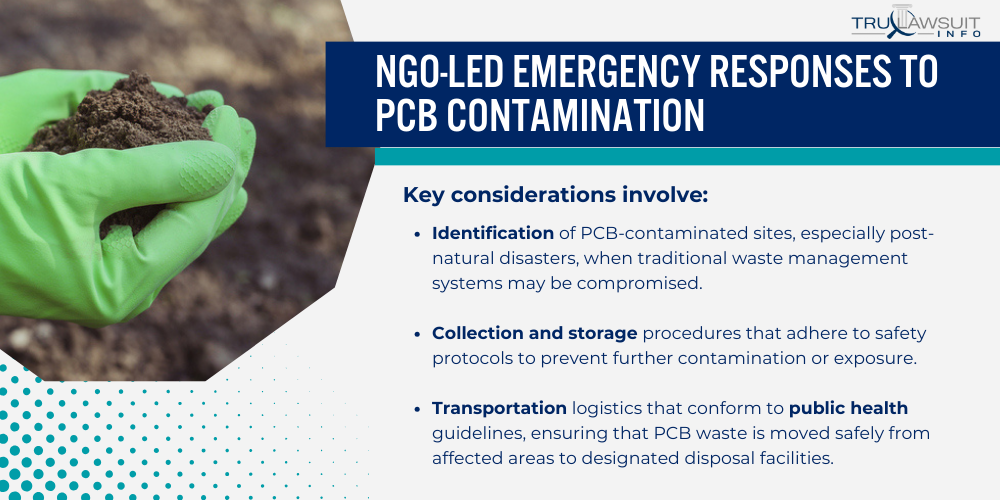
They provide technical expertise and support in the cleanup process and help in managing public health risks.
Planning and Implementing PCB Waste Management Post-Disasters
In the wake of disasters, NGOs often step in to assist with the management of PCB waste, ensuring that contaminated materials are handled properly to mitigate environmental and health hazards.
Key considerations involve:
- Identification of PCB-contaminated sites, especially post-natural disasters, when traditional waste management systems may be compromised.
- Collection and storage procedures that adhere to safety protocols to prevent further contamination or exposure.
- Transportation logistics that conform to public health guidelines, ensuring that PCB waste is moved safely from affected areas to designated disposal facilities.
- Disposal methods, such as incineration or chemical dechlorination, are selected based on the type and concentration of heat-degraded PCBs present in the waste materials.
NGOs collaborate with government agencies like the National Weather Service to predict and prepare for environmental disasters that could disperse PCBs, thereby integrating emergency response plans with timely weather alerts.
Addressing PCB in Electrical Equipment with NGO Support
NGOs work closely with communities and industries to identify and manage PCBs present in electrical equipment.
This collaboration is essential in preventing potential disasters and safeguarding public health.
Their support extends to:
- Education initiatives aimed at raising awareness about the dangers of PCBs in outdated electrical equipment.
- Assessment programs to evaluate the presence of PCBs in transformers and capacitors, especially in regions prone to natural disasters.
- The retrofitting or replacement of equipment that contains or is contaminated with commercial PCBs, supported by financial aid or expertise from NGOs.
- Monitoring efforts post-intervention to ensure that replaced or retrofitted equipment does not pose a public health threat.
Through these targeted efforts, NGOs can significantly reduce the risk of PCB exposure from electrical equipment, particularly during and after emergency responses and in the event of public health emergencies.
Addressing PCB Cleanup Violations Through NGO Interventions
When dealing with PCB cleanup issues, NGO interventions can play a pivotal role in both enhancing EPA’s existing penalty policies and advocating for more equitable punishments for violations.
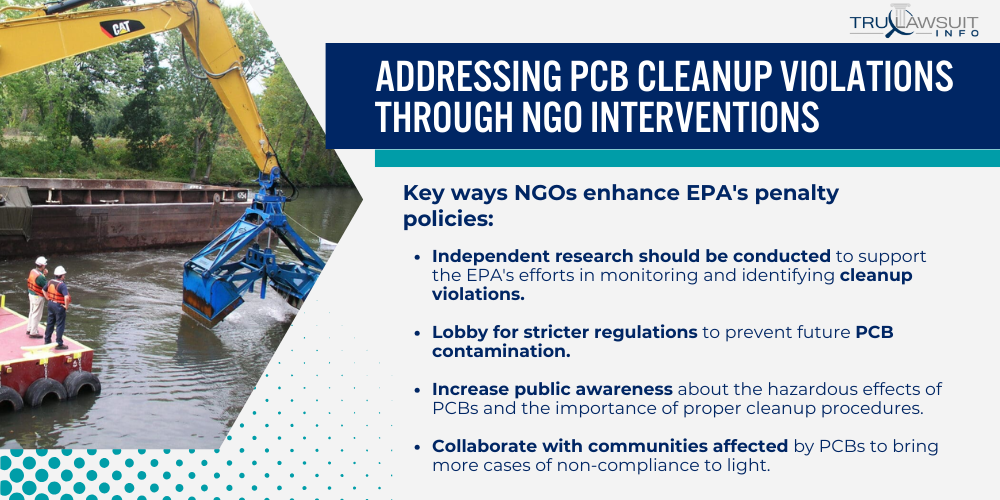
Enhancing EPA’s PCB Penalty Policies with NGO Involvement
Non-governmental organizations (NGOs) can significantly impact the enforcement of EPA’s PCB penalty policies.
Through collaboration and advocacy, NGOs work towards ensuring regulatory compliance and appropriate responses to violations.
Key ways NGOs enhance EPA’s penalty policies:
- Independent research should be conducted to support the EPA’s efforts in monitoring and identifying cleanup violations.
- Lobby for stricter regulations to prevent future PCB contamination.
- Increase public awareness about the hazardous effects of PCBs and the importance of proper cleanup procedures.
- Collaborate with communities affected by PCBs to bring more cases of non-compliance to light.
Advocating for Fair Penalties in PCB Cleanup Violations
NGOs are strong advocates for justice and ensure fair penalties for PCB cleanup violations.
Strategies used by NGOs to promote fair penalties:
- Engage legal experts to analyze current penalties and suggest adjustments for fairness and deterrence.
- Work alongside affected communities to ensure their voices are heard in the cleanup process.
- Campaign for transparency from both the EPA and violators regarding the extent and impact of cleanup violations.
- Monitor the application and consistency of penalty policies to prevent unjust differences in the treatment of violators.
By focusing on these interventions, NGOs contribute to enforcing and complying with PCB regulations, providing a more balanced approach to environmental justice and community safety.
Maximizing the Impact of PCB Cleanup for Community Wellbeing
Polychlorinated biphenyls (PCBs) are hazardous substances that have been linked to various environmental and health issues.
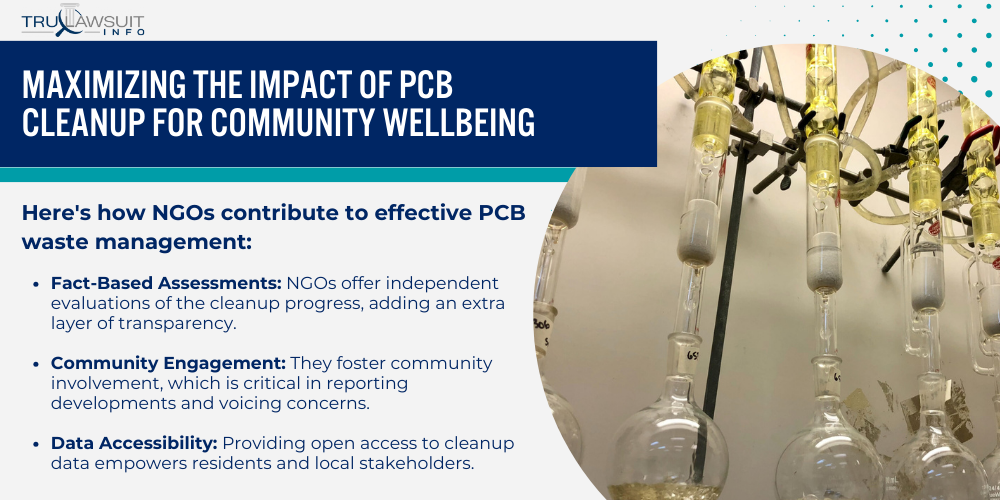
Effective cleanup of PCB-contaminated sites is essential to restore community wellbeing.
This section explores the role of non-governmental organizations (NGOs) in enhancing PCB waste management and promoting greener remediation practices.
Tracking PCB Waste Management Progress with NGO Participation
Non-governmental organizations play a pivotal role in monitoring PCB cleanups.
They ensure that both the process and outcomes meet the community’s expectations for a safe environment.
Here’s how NGOs contribute to effective PCB waste management:
- Fact-Based Assessments: NGOs offer independent evaluations of the cleanup progress, adding an extra layer of transparency.
- Community Engagement: They foster community involvement, which is critical in reporting developments and voicing concerns.
- Data Accessibility: Providing open access to cleanup data empowers residents and local stakeholders.
- Advocacy for Accountability: NGOs advocate for responsible waste management and compliance with regulations.
The benefits of the PCB Cleanup and Disposal Program highlight how improved waste management benefits communities.
NGOs in the Forefront of Ensuring Thorough PCB Contamination Cleanup
NGOs strive to guarantee that cleanup efforts are not only conducted but done so to comprehensive standards, safeguarding public health and environmental quality.
Here’s how NGOs achieve thorough PCB contamination cleanup:
- Research and Documentation: They scrutinize studies and records to push for more effective remediation strategies.
- Policy Influence: NGOs influence policy-making to ensure stringent cleanup measures are adopted.
- Expert Collaboration: These organizations often collaborate with experts to identify areas needing more stringent cleanup.
- Stakeholder Mediation: NGOs mediate between the affected community and responsible parties to affirm that cleanups are thorough.
Evidence of NGO-driven efforts can be found in the Managing Remediation Waste from Polychlorinated Biphenyls guidance.
Adopting Greener Cleanup Practices through NGO Advocacies
Environmental sustainability is at the heart of modern PCB remediation efforts, with NGOs advocating for practices that minimize ecological impact.
Here’s how NGOs promote greener PCB cleanup practices:
- Promoting Best Practices: NGOs campaign for the adoption of proven eco-friendly methods.
- Reduction of Carbon Footprint: They push for cleanup options that consume less energy and produce fewer emissions.
- Education on Alternatives: Education drives by NGOs help spread awareness of sustainable technologies.
- Continuous Improvement: NGOs continually refine cleanup practices, ensuring they remain cutting-edge and effective.
The Greener Cleanups Best Management Practices factsheet is a valuable resource for insight into eco-friendly remediation.
Frequently Asked Questions
-
What are the symptoms of PCB exposure?
Symptoms resulting from PCB exposure can vary but often include skin conditions such as chloracne and rashes.
Other early signs may involve eye irritation, nausea, and fatigue.
-
What are the long-term effects of PCB exposure on human health?
Long-term exposure to PCBs is linked with several significant health issues including effects on the immune, reproductive, nervous, and endocrine systems.
Occupational exposure to PCBs can result in a broad spectrum of effects that includes increased levels of some liver enzymes, with possible hepatic damage.
Prolonged contact may also lead to memory and cognitive deficits.
-
How can someone be exposed to PCBs?
PCB exposure primarily occurs through the consumption of contaminated food, especially fish, meat, and dairy.
Other pathways include air inhalation near contaminated sites and skin contact with contaminated materials.
-
What is considered a safe or normal level of PCBs in the human body?
There is no universally accepted “safe” or “normal” level of PCBs in the body; any detectable amount could potentially be harmful.
Regulatory bodies strive to keep levels as low as possible to minimize risk.
-
Which types of cancers have been linked to PCB exposure?
Exposure to PCBs has been associated with an increased risk of several cancers, the linkage being notably strong with melanoma, liver, gallbladder, gastrointestinal tract, and biliary tract cancers.
-
What methods are available for detoxifying the body from PCBs?
Detoxification from PCBs is a complex process, as these compounds can persist in the body.
Medical interventions may include chelation therapy, though dietary adjustments and avoiding further exposure are the primary recommendations.
-
Can PCB exposure affect infants through human milk?
Yes, PCB exposure can impact infants through human milk.
PCBs have been found to accumulate in adipose tissue, and because they are lipophilic (fat-loving) compounds, they can transfer from a mother’s adipose tissue into breast milk.
Consequently, infants can be exposed to PCBs through breastfeeding.
-
How do PCBs affect thyroid hormones and contribute to developmental delays and behavioral problems?
PCBs can disrupt thyroid hormone regulation in the body, leading to various developmental and behavioral issues.
Thyroid hormones play a crucial role in brain development, particularly during fetal development and early childhood.
PCBs can interfere with the production, transport, and utilization of thyroid hormones, leading to developmental delays in children.

Experienced Attorney & Legal SaaS CEO
With over 25 years of legal experience, Jessie is an Illinois lawyer, a CPA, and a mother of three. She spent the first decade of her career working as an international tax attorney at Deloitte.
In 2009, Jessie co-founded her own law firm with her husband – which has scaled to over 30 employees since its conception.
In 2016, Jessie founded TruLaw, which allows her to collaborate with attorneys and legal experts across the United States on a daily basis. This hypervaluable network of experts is what enables her to share reliable legal information with her readers!
Have A Case?
Here, at Tru Lawsuit Info, we’re committed to helping victims get the justice they deserve.
To do this, we actively work to connect them with attorneys who are experts in litigating cases similar to theirs.
Would you like our help?
Tru Lawsuit Info is a reliable source of information about issues that may affect your health and safety, such as faulty products, data breaches, and environmental hazards.
Our team of experienced writers collaborates with medical professionals, lawyers, and advocates to produce informative articles, guides, and other resources that raise awareness of these topics.
Our thorough research provides consumers with access to reliable information and updates on lawsuits happening around the country. We also can connect consumers with attorneys if they need assistance.
Camp Lejeune's water contamination issue spanned several decades starting in the 1950s. Exposure to these chemicals has been linked to various serious health issues, including cancer, organ diseases, and death.
Research is increasingly suggesting a link between the use of Tylenol during pregnancy and the development of neurodevelopmental disorders, such as autism and ADHD, in infants.
Legal action is being taken against manufacturers of Aqueous Film-Forming Foam (AFFF), a chemical used in fighting fires. The plaintiffs allege that exposure to the foam caused health issues such as cancer, organ damage, and birth and fertility issues.
Have A Case?
Here, at Tru Lawsuit Info, we’re committed to helping victims get the justice they deserve.
To do this, we actively work to connect them with attorneys who are experts in litigating cases similar to theirs.
Would you like our help?







